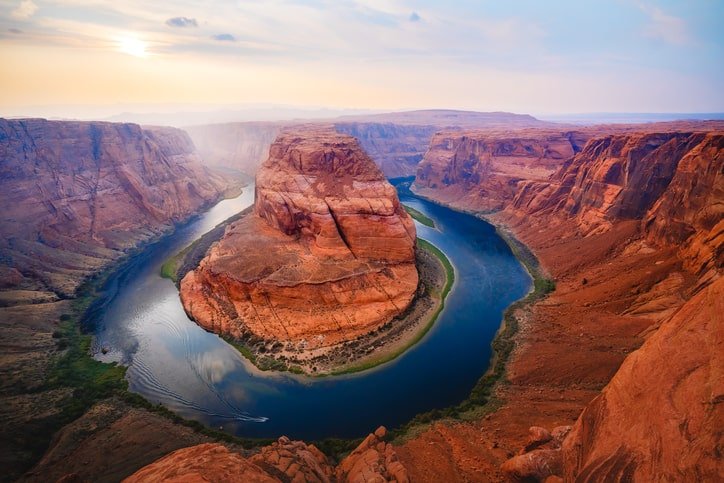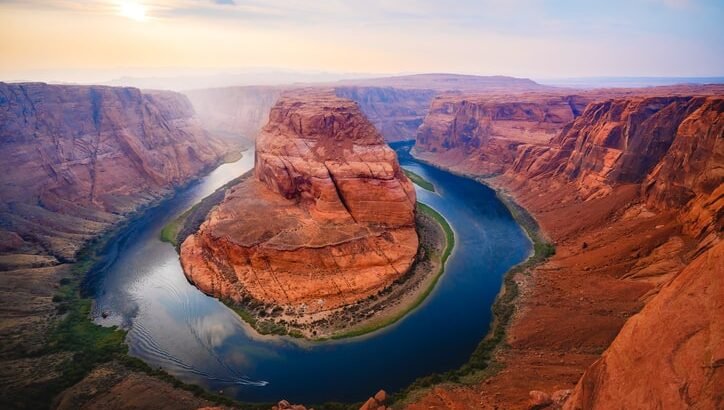
In the vast American Southwest, where rugged desert landscapes stretch beyond the horizon and the sun paints the sky with hues of fire, lies one of Earth’s most awe-inspiring natural wonders—the Grand Canyon. Carved by the relentless force of the Colorado River over millions of years, the Grand Canyon is more than just a canyon. It is a cathedral of stone, time, and silence, embodying the raw power of nature and the depth of geological history like no other place on Earth.
Located in northern Arizona, the Grand Canyon is a UNESCO World Heritage Site, a National Park, and a natural masterpiece that draws nearly six million visitors each year. Its staggering dimensions—277 miles (446 km) long, up to 18 miles (29 km) wide, and over a mile (1.6 km) deep—defy imagination. Yet numbers alone cannot capture the feeling of standing at the rim and gazing into its vast, colorful, and layered depths.
This is a place to reflect, to explore, and to feel small in the face of nature’s magnificence.
A Geological Story Billions of Years in the Making
The Grand Canyon is often described as a “window into deep time.” Its rock layers chronicle a history that spans nearly two billion years—almost half the age of the Earth itself. As you peer into the canyon’s multi-hued walls, you are literally looking at time frozen in stone.
- The oldest rocks at the bottom, the Vishnu Schist, date back 1.8 billion years.
- Above them, sedimentary layers like the Bright Angel Shale and Kaibab Limestone preserve fossils, ancient seabeds, and clues to prehistoric environments.
- The Colorado River, still carving the canyon today, has exposed these layers through eons of erosion.
Each stratum tells a story: of oceans and deserts, of volcanic eruptions and ancient rivers, of life and extinction. For geologists, the Grand Canyon is a treasure trove. For visitors, it’s a canvas of Earth’s past rendered in colors of red, gold, and amber.
A Landscape That Awakens the Soul
The beauty of the Grand Canyon is not just visual—it is deeply emotional. The scale, silence, and light shift your perspective. At sunrise or sunset, when golden light catches the cliffs and paints the walls with shadows and fire, it can be overwhelming.
From the rim, the view is an endless chasm of towering mesas, sharp ridges, and winding gorges. But venture into the canyon itself—by foot, mule, or raft—and the landscape transforms. You encounter hidden waterfalls, desert oases, rare wildlife, and a sense of peace and solitude unlike anywhere else on Earth.
This isn’t a place you merely see. It’s a place you feel.
South Rim vs. North Rim: Two Sides, One Wonder
The Grand Canyon has two main visiting areas: the South Rim and the North Rim, each offering distinct perspectives and experiences.
South Rim
- Most popular and accessible, open year-round.
- Home to Grand Canyon Village, visitor centers, museums, and famous viewpoints like Mather Point, Yavapai Point, and Desert View Watchtower.
- Offers the classic panoramic views and well-developed trails, including the Bright Angel Trail and South Kaibab Trail.
North Rim
- Higher elevation, more remote, and less crowded.
- Open only mid-May to mid-October due to snow.
- Cooler temperatures, thicker forests, and a more serene atmosphere.
- Viewpoints like Bright Angel Point offer stunning perspectives from a different angle.
Each rim has its magic. The South Rim is perfect for first-time visitors; the North Rim is ideal for those seeking solitude and deeper immersion in nature.
Hiking Into the Depths: An Unforgettable Journey
Standing on the edge is breathtaking, but hiking into the Grand Canyon is a transformational experience.
The trails challenge your body and elevate your spirit. Descending into the canyon is like walking into another world—the temperature rises, the vegetation changes, and time seems to slow down.
Popular trails include:
Bright Angel Trail
- Well-maintained, shaded, with rest houses and water stations.
- Leads to Indian Garden, Plateau Point, and eventually to Phantom Ranch at the canyon floor.
South Kaibab Trail
- Steeper and more exposed but offers some of the most dramatic views.
- Key stops: Ooh Aah Point, Cedar Ridge, and Skeleton Point.
North Kaibab Trail
- The only maintained trail into the canyon from the North Rim.
- Connects with the South Rim via the Rim-to-Rim hike, one of the most epic treks in North America.
Note: Hiking to the bottom and back in one day is not recommended unless you’re very fit and well-prepared. Heat, dehydration, and fatigue are serious risks.
Whitewater Rafting on the Colorado River
For the ultimate adventure, journey down the Colorado River that carved the Grand Canyon. A rafting expedition lets you experience the canyon from its deepest, wildest core.
- Multi-day trips (ranging from 3 to 21 days) take you through rapids, hidden beaches, side canyons, and ancient Ancestral Puebloan ruins.
- Sleeping under the stars in the canyon is an otherworldly experience.
- Trips are led by expert guides and often booked months or even years in advance.
Rafting the Grand Canyon is not just thrilling—it’s a pilgrimage through deep time and wilderness.
The Spiritual and Cultural Legacy
Long before it was a tourist destination, the Grand Canyon was—and remains—a sacred place to Native American tribes, including the Havasupai, Hopi, Hualapai, Navajo, and Zuni peoples.
They believe the canyon is a place of creation, spirits, and ancestral stories. You’ll find petroglyphs, ancient granaries, and ceremonial sites throughout the canyon’s remote areas.
Tribes like the Hualapai and Havasupai still live in and near the canyon, offering cultural tours and sharing traditional knowledge. The Havasupai Reservation, accessible only by foot or helicopter, is home to turquoise waterfalls like Havasu Falls, often called the most beautiful in the world.
To visit the Grand Canyon respectfully is to acknowledge its deep cultural significance and spiritual essence.
Skywalk and Scenic Flights: New Ways to See the Canyon
If hiking isn’t your thing, there are still plenty of ways to experience the grandeur:
Grand Canyon Skywalk
- Located at Grand Canyon West on the Hualapai Reservation.
- A glass bridge extending 70 feet over the canyon rim, offering a heart-stopping view straight down.
- Popular for thrill-seekers and those short on time.
Helicopter and Airplane Tours
- Take off from Las Vegas, Flagstaff, or the Grand Canyon airport.
- Provide bird’s-eye views of the Colorado River, rock formations, and sweeping canyon landscapes.
- Sunrise and sunset flights are particularly spectacular.
Photography and Stargazing: Art Meets Nature
For photographers, the Grand Canyon is an endless source of inspiration. The interplay of light and shadow, the vivid rock colors, and the dramatic skies create unforgettable compositions.
Golden hours—sunrise and sunset—offer the most magical light. Locations like Hopi Point, Desert View, and Cape Royal are favorites among professionals.
At night, the Grand Canyon transforms again. Recognized as an International Dark Sky Park, the sky explodes with stars, constellations, and even the Milky Way. Ranger-led stargazing programs offer guided experiences into the universe above.
When to Visit and How to Prepare
- Best Time to Visit: Spring (March–May) and Fall (September–November) offer mild temperatures and fewer crowds.
- Summer is busy and hot; winter brings snow and serene beauty, especially on the North Rim.
- What to Bring: Sunscreen, water, sturdy shoes, layers, and a sense of adventure.
- Where to Stay: Options range from lodges inside the park (like El Tovar Hotel) to campgrounds, hotels in nearby towns, and wilderness camping (with permits).
A Place That Changes You
The Grand Canyon isn’t just a place to check off a bucket list—it’s a destination that changes how you see the world. It teaches humility, ignites wonder, and brings you face to face with the power of time and nature.
Whether you’re watching condors soar above the cliffs, descending into hidden valleys, or simply standing at the edge lost in silence, one thing is certain: you’ll never forget your time here.
This isn’t just Arizona’s treasure—it’s the planet’s masterpiece, and an invitation to all who seek the sublime.




